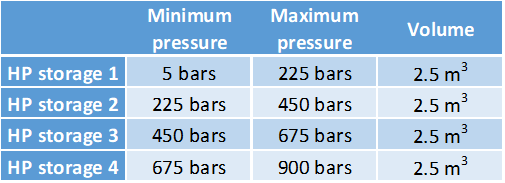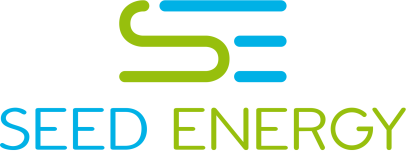How to compare hydrogen refueling system using either a single high-pressure storage tank or a cascade of multi-pressure storage tanks?

Thanks to the large library of energy management strategy control algorithms developed in ODYSSEY, it is simple and fast to evaluate and compare several scenarios of production, distribution, storage, uses.
In this example, the goal is to evaluate the gain in compression energy between two hydrogen refueling systems, one using a single high-pressure storage tank and the second using a cascade of multi-pressure storage tanks.
The figures below illustrate examples of these 2 system architectures:

The first system consists in:
- LP Storage: Low-pressure tank (e.g. 30 bars) used to store hydrogen after production and as a source tank for compression
- HP Storage: High-pressure tank (e.g. 900 bars) used to store hydrogen after compression and as a source tank to fill the vehicles
- HP Compressor: H2 compressor allowing to compress hydrogen from 30 bars to the HP storage pressure (maximum pressure of 900 bars)
- Dispenser: Hydrogen dispenser from which vehicles can be filled-in
The second system consists in:
- LP Storage: Low-pressure tank (e.g. 30 bars) used to store hydrogen after production and as a source tank for compression
- HP Storage 1, 2, 3 and 4: 4 tanks allowing to store hydrogen after compression and used as source tanks to fill the vehicles
- HP Compressor: H2 compressor allowing to compress hydrogen from 30 bars to the pressure of the connected tank among tank 1, 2, 3 or 4 (maximum pressure of 900 bars)
- Dispenser: Hydrogen dispenser from which vehicles can be filled-in
- 3-Way valve 1, 2, 3 and 4: 4 three-way valves to fill and/or empty the tanks
For this comparative study, we assume:
- A frequentation of the station of 4 vehicles per day (all year long) by a type of vehicle with the following characteristic

- The compressor features are the same in both systems (see table below)

- The total tank volume is identical in both systems (with the same investment cost). On the other hand, the pressure levels of the tanks of the second system are “spread” between 5 and 900 bars. (see table below)


For the operation of this cascade of multi-pressure storage tanks, we have implemented a specific control (algorithm) whose objective is to limit the total compression work (i.e. the electricity costs to operate the compressor) and whose principle can be summarized as follows:
- When a vehicle arrives and connects to the dispenser, the tank at the pressure immediately above the vehicle's internal tank pressure level is selected. The 3-way valve attached to this tank is opened to allow the tank to be emptied and the vehicle's internal tank to be filled;
- Filling takes place from the selected tank until equilibrium pressure is reached between the source tank and the vehicle tank;
- When equilibrium pressure is reached, the valve attached to the source tank is closed and the tank at the pressure immediately above the new pressure of the vehicle's internal tank is selected. The 3-way valve attached to this tank is opened to allow the tank to be emptied and the vehicle's internal tank to be filled;
- The process is repeated until the vehicle tank is completely filled (700 bars pressure).
- We started from the hypothesis of using the lowest pressure hydrogen possible (i.e. having the least cost of compression energy) while being at a high enough pressure to fill or continue filling the vehicle's tank.
After using dynamic simulation, and thanks to specific and smart controls, the main results of the study are:

In conclusion, the use of multi-pressure cascade storage tanks reduces the electricity requirement for compressor operation by over 20%. The second architecture combined with a smart energy management strategy allow substantial energy and cost savings on the compressor operation.
For more information contact SEED-Energy on +33 6 95 33 50 58 or by email: contact@seed-energy.fr
We support you in your hydrogen projects!

